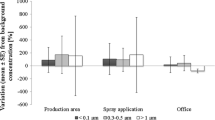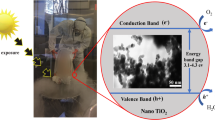Abstract
Titanium dioxide nanoparticles (n-TiO2) are added to photocatalytic mortars to improve urban air quality. Their activity can be increased by dispersing and binding them on natural sepiolite surface. Workers handling photocatalytic additives can be exposed to n-TiO2. However, the release of nanoparticles to the workplace can be different if the material used is raw n-TiO2 powders or if the nanoparticles are supported on sepiolite. In this work, we compare occupational exposure to n-TiO2 for raw n-TiO2 and a hybrid additive n-TiO2/sepiolite obtained by a proprietary process. Measurements were performed in two industrial sites that process 1 ton batches of mortars, formulated with the same quantity of n-TiO2, followed by their application outdoors. Direct reading instruments were used to monitor particle number concentration and size distribution. Simultaneously, filter-based samples were collected for mass concentration and microscopy analysis. Two tasks produced a significant release of particles, the addition of fillers during the mortar formulation, in site 1, and the mixing of mortar with water for its application in the second site. For the first task, particle concentration was significantly lower when the n-TiO2/sepiolite was added compared to the raw n-TiO2. For the second task, once the mortar is fully formulated, this metric does not identify differences among the batches. Titanium mass concentration was 3–10 times lower when handling the mortar formulated with the hybrid additive. These results suggest that supporting the n-TiO2 on the sepiolite network not only increases the photocatalytic activity, but is also a safer design that reduces exposure to nanoparticles.
Article Highlights
-
Titanium mass concentration was 3–10 times lower when handling the mortar based on the n-TiO2/sepiolite hybrid additive.
-
Direct reading instruments (DRIs) do not allow to compare worker exposure to n-TiO2 due to their lack of chemical selectivity.
-
Occupational exposure to n-TiO2 was below selected reference limits.
-
The n-TiO2/sepiolite hybrid additive improves the mortars photocatalytic activity and reduce the worker exposure to n-TiO2.








Similar content being viewed by others
References
Álvarez A, Casado AM, Esteban-Cubillo A, Gravalos J, Sanchez A, Santarén J, Vera J (2013) Process for the preparation of an additive comprising supported and dispersed TiO2 particles. World Patent Application WO2013020972. https://patentscope.wipo.int/search/en/detail.jsf?docId=WO2013020972. Accessed 14 Feb 2013
Asbach C (2015) Exposure measurement at workplaces. In: Patricia ID (ed) Nano engineering: global approaches to health and safety issues. Elsevier, Amsterdam. https://doi.org/10.1016/B978-0-444-62747-6.00016-6
Brouwer D (2010) Exposure to manufactured nanoparticles in different workplaces. Toxicology 269:120–127. https://doi.org/10.1016/j.tox.2009.11.017
Brouwer DH, Links IH, De Vreede SA, Christopher Y (2006) Size selective dustiness and exposure; simulated workplace comparisons. Ann Occup Hyg 50:445–452. https://doi.org/10.1093/annhyg/mel015
Dahmann D (2016) Exposure assessment: methods. In: Viana M (ed) Indoor and outdoor nanoparticles: determinants of release and exposure scenarios. Springer International Publishing, Cham, pp 51–72. https://doi.org/10.1007/698_2015_436
López de Ipiña JML et al (2017) Implementation of a safe-by-design approach in the development of new open pilot lines for the manufacture of carbon nanotube-based nano-enabled products. J Phys Conf Ser 838:012018. https://doi.org/10.1088/1742-6596/838/1/012018
Donaldson K, Murphy F, Schinwald A, Duffin R, Poland CA (2011) Identifying the pulmonary hazard of high aspect ratio nanoparticles to enable their safety-by-design. Nanomedicine 6:143–156. https://doi.org/10.2217/nnm.10.139
Egerton T, Tooley I (2014) Physical characterization of titanium dioxide nanoparticles. Int J Cosmet Sci 36:195–206. https://doi.org/10.1111/ics.12113
EN 17058:2018 workplace exposure—assessment of exposure by inhalation of nano-objects and their aggregates and agglomerates
Esteban-Cubillo A, Pina-Zapardiel R, Moya J, Barba M, Pecharromán C (2008) The role of magnesium on the stability of crystalline sepiolite structure. J Eur Ceram 28:1763–1768. https://doi.org/10.1016/j.jeurceramsoc.2007.11.022
Evans DE, Turkevich LA, Roettgers CT, Deye GJ, Baron PA (2012) Dustiness of fine and nanoscale powders. Ann Occup Hyg 57:261–277. https://doi.org/10.1093/annhyg/mes060
Fernandez-Rosas E et al (2016) Influence of nanomaterial compatibilization strategies on polyamide nanocomposites properties and nanomaterial release during the use phase. Environ Sci Technol 50:2584–2594. https://doi.org/10.1021/acs.est.5b05727
Heitbrink WA, Todd WF, Cooper TC, O'Brien DM (1990) The application of dustiness tests to the prediction of worker dust exposure. Am Ind Hyg Assoc 51:217–223. https://doi.org/10.1080/15298669091369565
Inagaki S, Fukushima Y, Doi H, Kamigaito O (1990) Pore size distribution and adsorption selectivity of sepiolite. Clay Miner 25:99–105. https://doi.org/10.1180/claymin.1990.025.1.11
ISO/TS 12025:2012. Nanomaterials—quantification of nano-object release from powders by generation of aerosols
Koivisto AJ, Lyyranen J, Auvinen A, Vanhala E, Hameri K, Tuomi T, Jokiniemi J (2012) Industrial worker exposure to airborne particles during the packing of pigment and nanoscale titanium dioxide. Inhal Toxicol 24:839–849. https://doi.org/10.3109/08958378.2012.724474
Kraegeloh A, Suarez-Merino B, Sluijters T, Micheletti C (2018) Implementation of safe-by-design for nanomaterial development and safe innovation: why we need a comprehensive approach. Nanomaterials 8:239. https://doi.org/10.3390/nano8040239
Kuhlbusch TAJ, Neumann S, Fissan H (2004) Number size distribution, mass concentration, and particle composition of PM1, PM2.5, and PM10 in bag filling areas of carbon black production. J Occup Environ Hyg 1:660–671. https://doi.org/10.1080/15459620490502242
Levin M et al (2015) (2015) Influence of relative humidity and physical load during storage on dustiness of inorganic nanomaterials: implications for testing and risk assessment. J Nanopart Res 17:337. https://doi.org/10.1007/s11051-015-3139-6
Lidén G (2006) Dustiness testing of materials handled at workplaces. Ann Occup Hyg 50:437–439. https://doi.org/10.1093/annhyg/mel042
McConnochie K, Bevan C, Newcombe RG, Lyons JP, Skidmore JW, Wagner JC (1993) A study of Spanish sepiolite workers. Thorax 48(4):370–374. https://doi.org/10.1136/thx.48.4.370
Movia D et al (2014) A safe-by-design approach to the development of gold nanoboxes as carriers for internalization into cancer cells. Biomaterials 35:2543–2557. https://doi.org/10.1016/j.biomaterials.2013.12.057
Naatz H et al (2017) Safe-by-design CuO nanoparticles via Fe-doping, Cu–O bond length variation, and biological assessment in cells and zebrafish embryos. ACS Nano 11:501–515. https://doi.org/10.1021/acsnano.6b06495
NIOSH (2011) Current intelligence bulletin 63: occupational exposure to titanium dioxide. Department of Health and Human Services Centers for Disease Control and Prevention. National Institute for Occupational Safety and Health, Washington, DC
OECD (2015) Harmonized tiered approach to measure and assess the potential exposure to airborne emissions of engineered nano-objects and their agglomerates and aggregates at workplaces
Park SH (2018) Types and health hazards of fibrous materials used as asbestos substitutes. Saf Health Work 9(3):360–364. https://doi.org/10.1016/j.shaw.2018.05.001
Pecharromán C, Esteban-Cubillo A, Montero I, Moya JS, Aguilar E, Santarén J, Alvarez A (2006) Monodisperse and corrosion-resistant metallic nanoparticles embedded into sepiolite particles for optical and magnetic applications. J Am Ceram Soc 89:3043–3049. https://doi.org/10.1111/j.1551-2916.2006.01190.x
Raj K, Viswanathan B (2009) Effect of surface area, pore volume and particle size of P25 titania on the phase transformation of anatase to rutile. Indian J Chem 48A:1378–1382
Raju B, Rom WN (1998) Silica, some silicates, coal dust and para-aramid fibrils. IARC monographs on the evaluation of carcinogenic risks to humans, vol. 68. Cancer Causes Control 9:351–353. https://doi.org/10.1023/A:1011242002145
Ruiz-Hitzky E (2001) Molecular access to intracrystalline tunnels of sepiolite. J Mater Chem 11:86–91. https://doi.org/10.1039/B003197F
Ruiz-Hitzky E, Aranda P, Álvarez A, Santarén J, Esteban-Cubillo A (2011) Advanced materials and new applications of sepiolite and palygorskite. In: Galán E, Singer A (eds) Developments in palygorskite-sepiolite research. A new outlook on these nanomaterials. Elsevier BV, Oxford, UK, pp 393–452. https://doi.org/10.1016/B978-0-444-53607-5.00017-7
Sangchay W, Sikong L, Kooptarnond K (2012) Comparison of photocatalytic reaction of commercial P25 and synthetic TiO2–AgCl nanoparticles. Procedia Eng 32:590–596. https://doi.org/10.1016/j.proeng.2012.01.1313
Spinazzè A, Cattaneo A, Limonta M, Bollati V, Bertazzi PA, Cavallo DM (2016) Titanium dioxide nanoparticles: occupational exposure assessment in the photocatalytic paving production. J Nanopart Res 18:1–12. https://doi.org/10.1007/s11051-016-3462-6
Suttiponparnit K, Jiang J, Sahu M, Suvachittanont S, Charinpanitkul T, Biswas P (2011) Role of surface area, primary particle size, and crystal phase on titanium dioxide nanoparticle dispersion properties. Nanoscale Res Lett 6:27. https://doi.org/10.1007/s11671-010-9772-1
The NANoREG2 Project (2019) A common European approach to the regulatory testing of manufactured nanomaterials. http://www.nanoreg2.eu/safe-design. Accessed 22 Feb 2019
UNI EN (2008) 11259: 2008 determination of the photocatalytic activity of hydraulic binders Rodammina test method
Van Teunenbroek T, Baker J, Dijkzeul A (2017) Towards a more effective and efficient governance and regulation of nanomaterials. Part Fibre Toxicol 14:54. https://doi.org/10.1186/s12989-017-0235-z
Vaquero C et al (2015) Occupational exposure to nano-TiO2 in the life cycle steps of new depollutant mortars used in construction. J Phys Conf Ser 617:012006. https://doi.org/10.1088/1742-6596/617/1/012006
Warheit DB, Sayes CM, Frame SR, Reed KL (2010) Pulmonary exposures to sepiolite nanoclay particulates in rats: resolution following multinucleate giant cell formation. Toxicol Lett 192(3):286–293. https://doi.org/10.1016/j.toxlet.2009.11.006
Xia T et al (2011) Decreased dissolution of ZnO by iron doping yields nanoparticles with reduced toxicity in the rodent lung and zebrafish embryos. ACS Nano 5:1223–1235. https://doi.org/10.1021/nn1028482
Yu J, Yu H, Cheng B, Zhou M, Zhao X (2006) Enhanced photocatalytic activity of TiO2 powder (P25) by hydrothermal treatment. J Mol Catal A Chem 253:112–118. https://doi.org/10.1016/j.molcata.2006.03.021
Acknowledgements
The work was supported by the European Community's Seventh Framework Programme (FP7) under Grant agreement no. 280535 (SCAFFOLD).
Author information
Authors and Affiliations
Corresponding author
Electronic supplementary material
Below is the link to the electronic supplementary material.
Rights and permissions
About this article
Cite this article
Vaquero, C., Esteban-Cubillo, A., Santaren, J. et al. Exposure Assessment During the Industrial Formulation and Application of Photocatalytic Mortars Based on Safer n-TiO2 Additives. Int J Environ Res 14, 257–268 (2020). https://doi.org/10.1007/s41742-020-00252-7
Received:
Revised:
Accepted:
Published:
Issue Date:
DOI: https://doi.org/10.1007/s41742-020-00252-7




